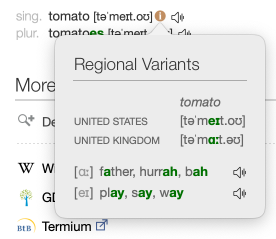Details
The panel on the right-hand side of the window has three sections (Details, Difficulties and More), offering a variety of complementary information on the headword. The main categories are explained below.
Etymology

Most words are accompanied by etymological information. The language of origin is displayed in orange, and clicking it takes you to the article on that language in the History guide.
The example on the right shows that the word passport is likely a borrowing from Middle French passeport, meaning “document enabling its bearer to enter a port”. Click the icon to see the word’s complete history.
Frequency index
A frequency index is shown for most words in the form of a point on a line going from 0 (rare) to 100 (frequent). This logarithmically calculated number shows the relative frequency of the word in a corpus of several billion words. A textual ranking (very frequent, fairly frequent, etc.) based on this index appears under the line. Hovering the mouse over the line will also display a tooltip ranking the word in terms of the number of other words of equal or higher frequency (e.g. Of the 500 most frequent words) in the corpus.
Inflected forms
Inflected forms of the headword are shown: singular and plural forms for nouns, comparative and superlative forms for adjectives and conjugated forms for verbs; clicking the icon to the right of the last verb form listed opens the dictionary of conjugations.
Phonetics and pronunciation With subscription


All word forms are accompanied by their phonetic transcription, which can be displayed in two alphabets. By default, Antidote displays the transcription using respelling. If you prefer to see the International Phonetic Alphabet (IPA), click the button to the right of the header and choose the Show IPA option from the drop-down menu. Click a transcription for examples of each phoneme used. Click the icon to the right of a transcription to see regional variants in pronunciation, when applicable.
Clicking the icon lets you listen to the pronunciation of the headword and all its possible inflections, as well as the words given as examples for the phonemes in the phonetic transcription, when it is displayed. These elements can be pronounced with a North American accent or with a British accent.
- The displayed phonetic transcription takes into account your national language variety, as defined in the User panel under Language in your settings. For the American English and Canadian English, Antidote displays the transcription of the word in North American English, and in British English for both varieties of British English.
- Your national language variety determines the accent used by default for pronunciation. To change it, click the button to the right of the header and choose the desired accent from the English voice drop-down menu.
- When phonetic transcription is displayed, Antidote automatically displays the transcription that corresponds to the chosen accent should the word or one of its forms be pronounced differently in North America versus the UK (e.g. advertisement).
- When audio pronunciation is available, Antidote displays the icon. If necessary, you can hide it in the settings (Interface > Access control > Audio content).
- Audio pronunciation requires a valid subscription.
Variants
When a word can be spelled in more than one way, the variants section displays the different possible spellings, reflecting the country of use and providing their relative frequency of use as a percentage—calculated from a corpus of several billion words. When a variant does not appear in the corpus, it is labelled rare.
Difficulty

Some words are subject to a particular set of usage conventions, which come with their own potential difficulties. These can relate to meanings, inflections, syntactic or grammatical requirements, etc., and specific usage information can be found for such words in the Difficulties section of the right-hand panel. The example opposite explains how the comparative and superlative forms of the adjective far may vary according to the intended meaning of the word.
Some sources of difficulty are the subject of their own guide article: an orange link will take you there directly.